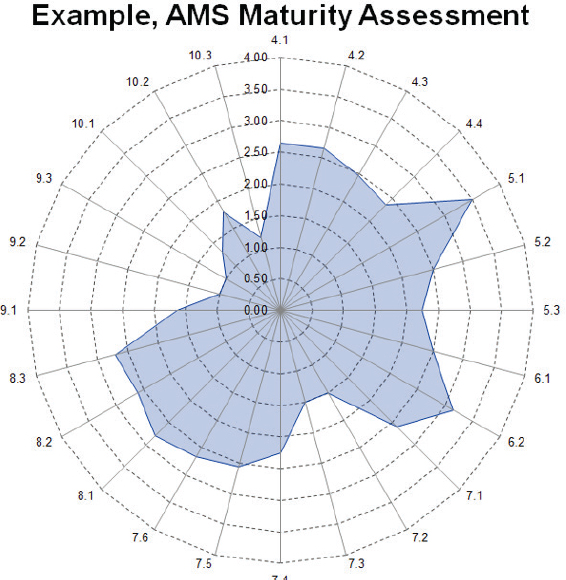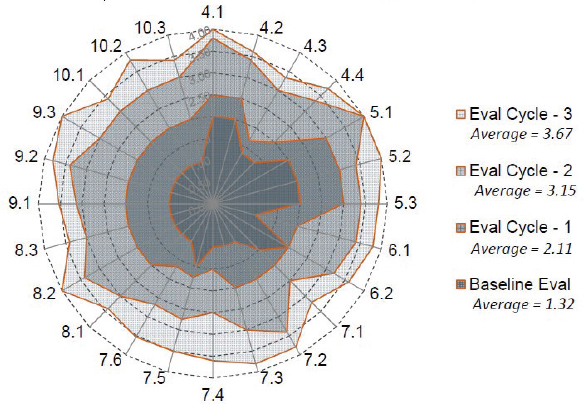F
Facility Asset Management Principles
This appendix further develops facility asset management principles introduced in Chapter 3. These principles serve as concepts and practices foundational to management system thinking and facility asset management systems.
DATA INTEGRITY PRINCIPLE
Data used must be held to integrity standards determined by
the facility asset management system’s decision-making needs.
Having accurate, relevant, and actionable data is a universal requirement to implementing federal facility renewal strategies. Many laws, regulations, and policies support this. This principle builds on this truth by providing additional stipulations. These stipulations are inherent to the agency’s facility asset management system. This creates an integrity logic loop essential to supporting organizational learning and continual improvement. This logic loop is summarized as follows:
- Decision-making objectives are established by the facility asset management system.
- Decision-making capabilities are limited by data made available by the facility asset management system.
- To improve decision making, the facility asset management system must continually improve the data made available by it and for it.
This logic loop defines the data integrity principle. It also promotes scalable implementation of facility asset management systems. This means agencies
have freedom to start small or use a narrow scope to establish initial facility asset management system capabilities. As data improve, so too will the facility asset management system, which will work to both improve data and generate a demand for more and better data.
ISO 55001 contains detailed information requirements that can assist this process.1 The International Organization for Standardization (ISO) 55001 requirements are not prescriptive; they are related to the asset management system scope set within a working decision-making framework. The takeaway of implementing this principle is that data integrity is entirely a function of an agency’s facility asset management system definition, and this principle cannot be applied until after this system is defined.
WHOLE LIFE-CYCLE COST ANALYSIS PRINCIPLE
Federal facility renewal strategies must cover
whole life-cycle costs of the assets in their scope.
Federal facility renewal strategies must have a whole life-cycle cost-analysis approach, as supported by generally accepted accounting principles and specific Office of Management and Budget (OMB) guidance. OMB guidance directs the use of GAO’s cost-estimating guidance, updated in 2020, in GAO-20-195G, Cost Estimating and Assessment Guide, which, although framed in terms of program management activities, provides excellent guidance suitable for facility asset management. To complement these activities, the development of federal facility renewal strategies must consider an integrated investment perspective that includes the entire life-cycle cost of facility assets to address renewal of the agency’s facility portfolio.
To achieve this, in complement to GAO-20-195G, agencies developing their federal facility renewal strategies can make use of ISO 15686—Buildings and Constructed Assets—Service Life Planning standards, especially Part 5 (Life Cycle Costing). This source covers life-cycle costing principles and settings, and decision-making variables for life-cycle cost and whole life cost analysis. Figure F-1 shows the relationship of whole life cost and life-cycle costs.
Figure F-2 expands on these relationships, defining life-cycle costings analyses from the perspectives of whole life, life-cycle costing for construction, and life-cycle costing in use. ISO 15686, Part 5, also recognizes different levels of life-cycle cost analysis, as shown in Figure F-3. This leads to a familiar observation on the influence on cost controls and costs incurred shown in Figure F-4, although this figure only represents a classic pattern of a single asset, rather than a view necessary for a whole portfolio of assets.
___________________
1 See ISO (2014b, § 7.5—Information Requirements for more details).
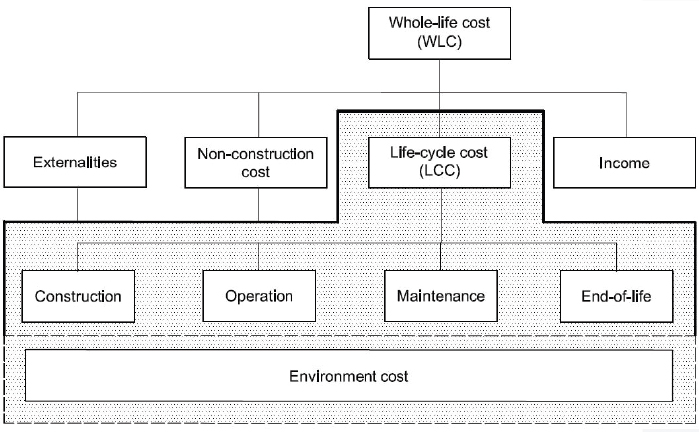
SOURCE: © ISO. This material is reproduced from ISO 15686-5:2017 with permission of the American National Standards Institute (ANSI) on behalf of the International Organization for Standardization. All rights reserved.
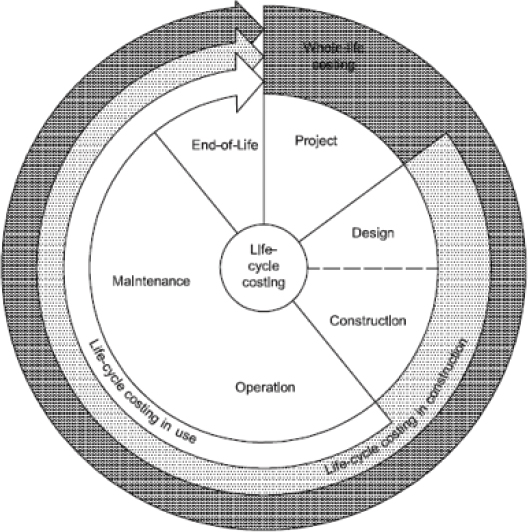
SOURCE: © ISO. This material is reproduced from ISO 15686-5:2017 with permission of the American National Standards Institute (ANSI) on behalf of the International Organization for Standardization. All rights reserved.
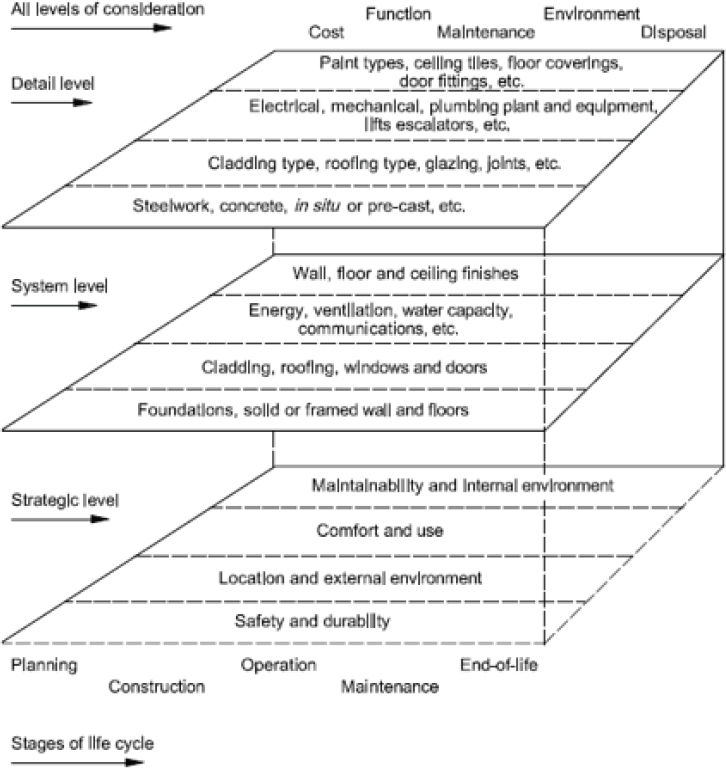
SOURCE: © ISO. This material is reproduced from ISO 15686-5:2017 with permission of the American National Standards Institute (ANSI) on behalf of the International Organization for Standardization. All rights reserved.
The committee applauds the work presented in ISO 15686, Part 5, and sees it as a foundational source defining whole life cost analyses supporting the development of federal facility renewal strategies. In practice, this means cost analysis supporting federal facility renewal strategies must go beyond guidance outlined in OMB Circular A-11—Preparation, Submission and Execution of the Budget; OMB Circular A-94—Guidelines and Discount Rates for Benefit-Cost Analysis of Federal Programs; and GAO-20-195G, Cost Estimating and Assessment Guide. Requirements in these sources generally address what ISO 15686, Part 5, defines as life-cycle costs relating to the acquisition of single-facility assets or real property programs with limited scope.
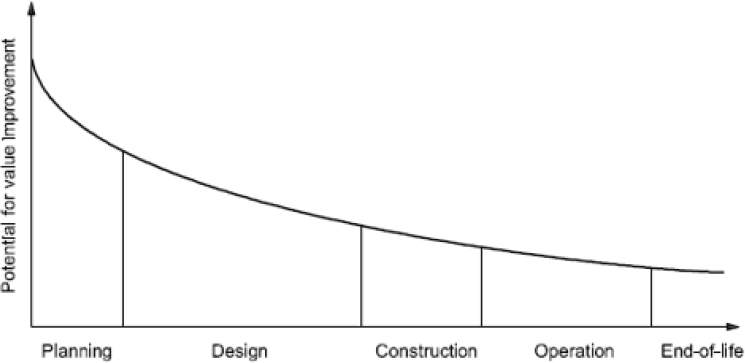
SOURCE: © ISO. This material is reproduced from ISO 15686-5:2017 with permission of the American National Standards Institute (ANSI) on behalf of the International Organization for Standardization. All rights reserved.
This will require advancing, or in some cases introducing, new approaches and federal guidelines. Current federal policy is insufficient for generating fully responsive federal facility renewal strategies because it does not apply a whole life perspective. Steps to address this could make use of ISO 15686—Buildings and Constructed Assets—Service Life Planning standards.
PORTFOLIO MANAGEMENT PRINCIPLE
Federal facility renewal strategies must support the
agency’s whole facility portfolio, covering whole life cycle
and stakeholder requirements across whole mission sets.
Effective facility asset management systems do not just happen; they are engineered. OMB guidance requires federal agencies to proactively manage their whole facility portfolio. Supporting statements in OMB Circular A-11’s Supplement—Capital Programming Guide (OMB 2022a) include the following:
Capital assets should be compared against one another to create a prioritized portfolio of all major capital assets. Just as an individual invests in a diverse portfolio of securities, agencies invest in a diverse portfolio of capital assets (p. 19).
In general, agencies should establish and manage portfolios of programs, projects, and other work in accordance with Federal policy and widely accepted standards. The coordinated management of the items in a portfolio
should enhance executive decision making and help ensure programs and projects contribute to an agency’s ability to achieve strategic goals and objectives. The process includes the selection, prioritization and monitoring of programs and projects, but it does not include the management of the items in a portfolio. The management of individual items should be addressed in program/project management policy (p. 19).
Portfolio management theory and standards are readily available from commercial sources and academic literature. The theory is not repeated here. Agencies are encouraged to focus on the practical application of the principles as opposed to the development of portfolio management theory. Most likely, the practical application will involve the tailoring of the principles to an agency’s unique circumstances (p. 19).
All of the items in a portfolio must support strategic plans, goals, objectives and priorities. The strategy and goals drive the selection and prioritization. The selection process should eliminate unnecessary and poorly planned projects. The selection and evaluation should result in a portfolio that is balanced so that the mix of items maximizes the agency’s ability to achieve strategic goals (p. 19).
Annual reviews should include key performance indicators and ensure that the portfolio only contains items that support the mission. In addition to reviewing portfolio performance, each item should be reviewed individually to evaluate its contribution (p. 19).
The [Agency Capital Plan] should include an analysis of the portfolio of assets already owned by the agency and in procurement, the performance gap and capability necessary to bridge it, and justification for new acquisitions proposed for funding (p. 20).
The Agency Capital Plan can support an agency’s related salaries and expenses associated with the staffing, operation, and maintenance of its capital asset portfolio (p. 21).
The agency should analyze their portfolio of capital assets, set goals and priorities for the optimization of the inventory, explain their use of performance indicators and analysis in decision making and develop a strategic timeline outlining improvement initiatives (p. 45).
A decision tree is just one of many diagnostic tools available to supplement agency portfolio analysis and provide additional information for decision making (p. 51).
Under the concept of continuous monitoring, the disposition of an asset should be a proactive process that occurs at the portfolio level (p. 72).
An examination of the existing portfolio of assets is encouraged in order to identify capital assets currently in use and in procurement that can help meet program objectives (p. 77).
To further develop implementation of a portfolio management approach, the Capital Programming Guide defines operative terms as follows:
Portfolio. A set of programs, projects or other work grouped together to meet strategic goals and objectives.
Program. An ongoing initiative composed of a group of projects and other work managed in a coordinated way to obtain benefits not obtained from managing them individually.
Project. A temporary endeavor to create a unique product or service with a start date, a completion date and a defined scope. (OMB 2022a, p. 91)
It is important to note that the above portfolio definition is focused on a group of work activities and not on a group of assets. This observation supplements the review of OMB policy contained in Appendix E and findings contained in Chapter 2. It is the committee’s opinion that defining a portfolio this way makes it difficult to implement facility asset management systems detailed in Chapter 3, which are needed for generating federal facility renewal strategies. This observation and supporting analysis led to the development of this principle.
ACCOUNTING TRANSPARENCY PRINCIPLE
Federal facility accounting structures must support integrated
and auditable analysis of financial and nonfinancial aspects to
perform facility asset management activities supporting
planned-versus-actual reconciliation of performance objectives.
Underpinning facility asset management are accounting standards. This point is made clear in ISO 55010—Guidance on the Alignment of Financial and Non-Financial Functions in Asset Management. Implementation of this standard is helpful for establishing the facility asset management systems capabilities detailed in Chapter 3.
Federal requirements in this area are based on numerous laws that include accountability and transparency requirements governing expenditure of public
funds. Notable examples include the Chief Financial Officers Act of 1990, the Government Performance and Results Act of 1993, and the Federal Funding and Accountability Act of 2006. The following OMB circulars confer related requirements:
- Circular A-11—Preparation, Submission and Execution of the Budget
- Circular A-94—Guidelines and Discount Rates for Benefit-Cost Analysis of Federal Programs
- Circular A-123—Management’s Responsibility for Enterprise Risk Management and Internal Control
- Circular A-131—Value Engineering
- Circular A-134—Financial Accounting Principles and Standards
- Circular A-136—Financial Reporting Requirements
In terms of federal facility asset management, these requirements manifest in two general forms: inventory accounting and financial accounting.
Executive Order 13327—Federal Real Property Asset Management introduced centralized federal real property inventory reporting (White House, 2004), requiring federal agencies to report facility inventories, and requiring the General Services Administration’s (GSA’s) Office of Government-wide Policy (OGP) to publish updated information in the Federal Real Property Profile. GSA-OGP has done so annually since this time. In 2016, the Federal Assets Sale and Transfer Act and the Federal Property Reform Act required agencies to submit an annual report on excess and underutilized real property and make an annual assessment of each real property asset covering a range of specific criteria.
The second form is financial accounting. A foundational element to financial accounting that is supportive of federal facility renewal strategies is object class codes defined by OMB Circular A-11, Section 83 (Object Classification). Object class codes track the type of expenditure but do not adequately differentiate common cost centers used in day-to-day facility asset management. This is a fundamental reason why agencies cannot generate simple balance sheets comparing whole required and available facility portfolio requirements over a portfolio—or in simple terms, generate a requirements-based budget and compare it to the actual budget.
This problem is rooted primarily in the fact that some object class codes cover many types of facility expenditures, grouping facility expenditures with nonfacility expenditures. This creates many-to-many relationships and introduces sources of error. As a result, it is impossible to account for agency facility management activities using the OMB object class code convention.
Current federal accounting conventions do not support agencies performing planned-versus-actual comparisons between the appropriations budgeted for facility operations and the funding spent on their facilities. Overcoming this deficiency is essential to being able to generate effective, impactful federal
facility renewal strategies. The committee views this accounting function as a fundamental requirement for facility asset management, and this lack is a failure in current federal policy.
Introducing object class codes that align with common facility management functions would be a positive step forward. In a single action, updating the object class codes in Circular A-11 would correct a serious flaw in facility accounting across the federal government. This advancement would simplify basic facility management, acquisition, and procurement accounting. Clarifying accounting requirements will naturally improve data transparency and streamline auditing activities. Furthermore, this foundation will promote communications helping executive decision makers understand the interrelationship between budgetary decisions and facility performance, all advancing the value and impact of federal facility renewal strategies.
MISSION ALIGNMENT PRINCIPLE
Mission alignment of resource prioritization requires the use of validated
and verifiable metrics to link the relative importance of individual facility
assets to agency missions and stakeholder performance expectations.
OMB Circulars A-11 and A-123 are clear that federal expenditures must be directed toward achieving the agency’s mission. These circulars further require use of internal controls to establish assurances this is happening. Facility asset management, by design, approaches resource decision making to achieve this purpose. It does this by evaluating the return on investment that each resourcing decision makes toward optimizing the agency’s facility portfolio supporting operations and mission achievement. This work is the motivation behind ISO 55000 and its emphasis that asset management is not about the asset, but about the value generated by the asset.
To accomplish this in practical ways, agencies must use measures that confer a relationship between mission and facility assets. This objective is supported in ISO 55002 and its development of risk management, as follows:
Risk management is essential in developing asset management objectives and plans, and ensuring decision making is in line with organizational objectives and stakeholder requirements. The guidelines given in ISO 31000 and IEC 31010 can be applied to defining and establishing a risk management approach that conforms to ISO 55001. (ISO 2014a, Appendix E)
Many agencies have accomplished this through the use of measures that report the relative importance of different facility assets from a mission execution perspective. The most widely practiced solution is the Mission Dependency Index (MDI), which is used by the Navy, Air Force, National Aeronautics and Space Administration, Army National Guard, and Coast Guard. Another is the
Asset Priority Index (API), used by the National Park Service. The OMB Capital Programming Guide cites both indices.
The Air Force uses the most capable and advanced MDI solution (USAF 2018). The committee considers it the most capable because it applies a simple operational readiness risk matrix based on probability and severity, supported by a set of data quality rules for reporting the relative importance of each facility asset. It calculates an MDI value for each distinct function at a location, as opposed to other methods that assign MDI scores to general facility types not based on the mission needs of a specific location.
The MDI uses the operational risk management ranking categories of probability and severity applied using terminology defining interpretability and replicability. Questions for each are asked on each key functional capability at a location to generate raw input using a common risk matrix (see example in Figure F-5). The Air Force then uses a set of rules to process inputs and calculates an MDI value for each asset, computing a relative measure of mission alignment. The MDI values provide a means to mission-weight different actions, such as prioritizing maintenance actions and projects, allowing the Air Force to align facility management activities with mission objectives.
The API offers an alternative method to the MDI. The API is static, based on multiple criteria related to the agency’s mission that are stewardship related. This is supported in the API definition used in ASTM E2495-18—Standard Practice for Prioritizing Asset Resources in Acquisition, Utilization, and Disposition. In the case of the National Park Service, API criteria include resource preservation, visitor use, park support, and asset substitutability (see GAO-17-136, National
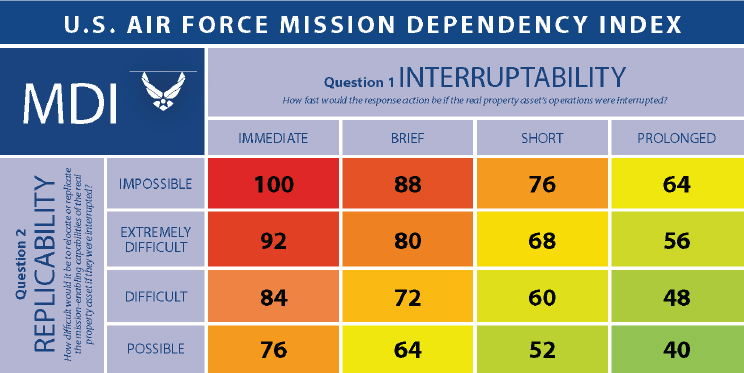
SOURCE: R. Weniger, 2018, “Setting Priorities: Tactical MDI Aligns Facilities to Mission,” Air Force Civil Engineers 26(1), Spring 2018, www.afcec.af.mil/Portals/17/documents/CE-Online/2018%20Spring%20CE%20mag.pdf.
Park Service—Process Exists for Prioritizing Asset Maintenance Decisions, But Evaluation Could Improvement Efforts). This method can be tailored to any agency’s needs and priorities.
The decision to use an MDI- or an API-type approach comes down to the agency’s mission. An MDI-type approach is best if an agency’s mission requires agility in responding to a dynamic operating environment. An MDI works best in this case because it is sensitive to a full range of changing operating conditions responsive to the needs of a dynamic operating environment. On the other hand, if the agency’s mission involves the delivery of products and services in a relatively unchanging operational environment, an API-type metric may be better. This is because the API-type method can consider a range of independent perspectives and uses a multicriteria decision analysis model to produce a relative ranking of facility assets. If the agency is response oriented, the MDI approach is better; if the agency is stewardship-oriented, the API approach is better. If resource decision making involves the need to respond to both operationally driven and stewardship objectives, the agency can define a mission alignment metric using inputs from both (see Figure F-6).
FACILITY PERFORMANCE PRINCIPLE
Knowledge of each facility asset’s condition, functionality, availability, and
utilization compared with agency-established standards is required to under-
stand the capabilities and performance of facility assets and portfolios.
The Capital Programming Guide promotes four performance metrics for continuously monitoring real property assets: (1) operating and maintenance costs, (2) utilization, (3) condition, and (4) mission dependency (OMB 2020a, §
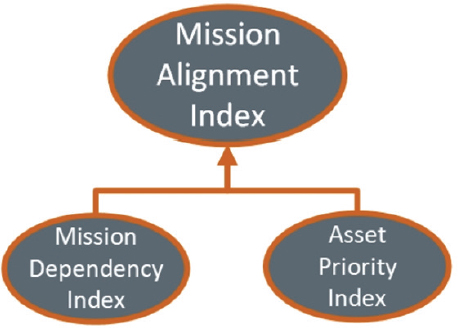
NOTE: This figure infers that there is a mathematical function jointing the Mission Dependency Index and Asset Priority Index into a new metric called a Mission Alignment Index, which would be used to support resource-and-investment decision making.
3.4.3). The committee agrees with these performance perspectives as a starting point and covers operating and maintenance cost evaluation in later principles and addresses mission dependency in the previous principle. Development of this principle focuses on reporting facility performance expanding on OMB’s use of utilization and condition performance metrics.
In the committee’s judgment, the following four perspectives constitute an exhaustive basis for determining and reporting the performance of a facility asset and facility portfolio:
- Condition—the physical performance of facility components and systems.
- Functionality—performance in terms of facility configuration other than condition.
- Availability—time a suitable facility is available to support an operating requirement (e.g., up-time).
- Utilization—the amount of time a suitable and available facility is used to support a requirement.
Other industry sources cover these metrics extensively, including the following National Academies publications:
- Predicting Outcomes of Investments in Maintenance and Repair of Federal Facilities (NRC 2012b)
- Investments in Federal Facilities: Asset Management Strategies for the 21st Century (NRC 2004b)
- Intelligent Sustainment and Renewal of Department of Energy Facilities and Infrastructure (NRC 2004a)
To produce a well-substantiated federal facility renewal strategy, facility performance assessments and metrics should:
- Be knowledge based—that is, constructed on specific engineering and use factors of the components, systems, and assets being evaluated (NRC 2012a)
- Use metrics that are validated and verified22
- Be based on clear, objective standards that enable accurate reporting of an asset’s or asset portfolio’s performance compared with a standard
- Be tailored to identify performance gaps that can be remedied by work actions defined in terms of scope, time, and level of effort to complete
Agencies must also organize facility assessment programs to provide actionable information suitable for documenting a comprehensive list of facility
___________________
2 For more information on this topic, see NRC (2012a).
requirements. This documentation is different from practices where agencies only seek to identify enough work given budget, resource, or capability limitations. The latter approach fails to identify risks and opportunities related to broader resourcing and management strategies. This is why the committee prefers a comprehensive assessment approach to developing federal facility renewal strategies. The committee also notes that there are many methods to achieve a comprehensive analysis and some modeling methods can be just as accurate and less costly than labor-intensive on-site inspections. Example modeling methods include condition-based assessments and parametric cost models derived from actual consumption patterns.
If agencies do not define facility renewal strategies based on a comprehensive evaluation of the facilities portfolios’ mission needs, stakeholder requirements, and whole life-cycle costs, they will be ignorant of many risks and causal relationships critical to optimizing resources supporting efficient and effective agency operations.
DECISION-MAKING ALIGNMENT AND ACCOUNTABILITY PRINCIPLE
Facility asset management system decision making must integrate
and reconcile objectives, resources, and performance management
activities to promote stakeholder confidence in them.
The preceding principles set a foundation for effective decision-making frameworks. This and succeeding principles focus on building confidence and trust in decision making. This is based on two objectives: alignment and accountability. First, decision making must be relevant and responsive to the agency’s facility asset management system decision-making needs. Second, decision-making frameworks must reinforce accountability. When done together, decision making will promote stakeholder confidence and trust in the federal facility renewal strategies generated by the agency’s facility asset management system.
The ISO 55001—Asset Management System—Requirements standard is designed to serve this purpose. The figure below presents a generic facility asset management system framework based on requirements contained in this standard configured to implement federal facility renewal strategies put in the context of federal policy.
This framework should be familiar to most agencies, with one distinction. Typically, it is presented in policy linking an agency’s strategic plan to its planning, programming, budgeting, and execution (PPBE) cycle as required in OMB Circular A-11. Figure F-7 shows how agencies would employ facility asset management systems to achieve this objective. In this case, the real property capital plan, guided by the agency’s facility renewal strategy, is developed to inform PPBE activities. OMB’s Capital Programming Guide details its purpose in doing this:
The Agency [Real Property] Capital Plan is the principal output of the Planning Phase. It is a dynamic plan that changes to reflect decisions about adding new assets and deleting old or even in-process asset acquisitions that are not meeting goals (i.e., the return on investment does not justify continued funding of the project). It should be the central document, or group of documents, that the agency uses for its capital asset planning. Agencies are encouraged to use a summary of the Agency [Real Property] Capital Plan for budget justifications to OMB, Congressional authorizations of projects, and justifications for appropriations to the Congress. (OMB 2022a)
The real property capital plan in OMB policy is synonymous with the strategic asset management plan used in ISO 55000 standards. Likewise, as depicted in the figure above, the real property capital plan translates organizational objectives into asset management objectives guided by the agency’s facility renewal strategy.
Asset management objectives defined and further developed in subordinate asset management plans establish SMART (specific, measurable, actionable, relevant, and time-bound) facility asset management objectives. Examples include maintaining facilities at specific condition, configuration, and operating standards. This framework indicates the real property capital plan will organize many
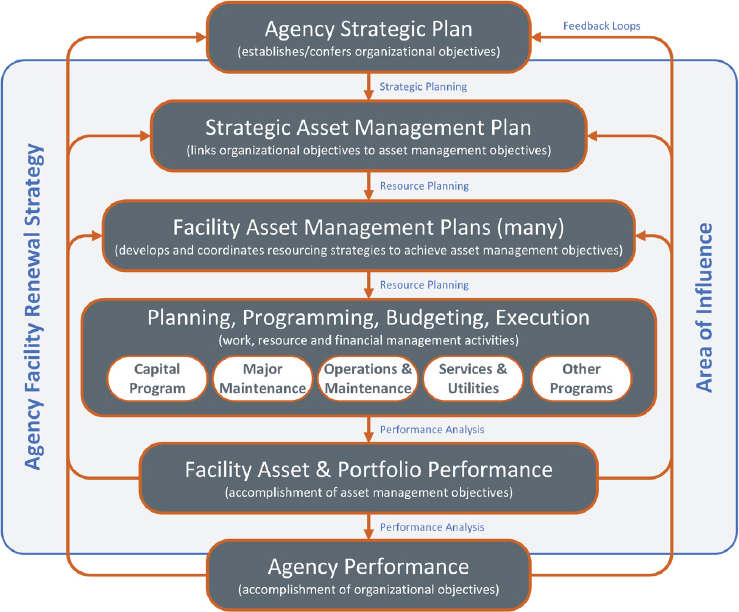
asset management plans depending on the size and complexity of the agency’s facility portfolio and asset management system.
The next step in the framework, and the objective of every facility asset management system, is integration with the agency’s PPBE process. The PPBE process is where the facility asset management system puts the facility renewal strategy into motion, guiding resource decision making compared with established performance objectives. The last aspect of this framework is configuring performance analysis as a feedback loop to improve next-cycle planning activities. When done correctly, each decision-making step clearly establishes its objective and its contribution to enterprise risk management, and defines the roles, responsibilities, and authorities of decision makers at every level. When this is accomplished, the decision-making alignment and accountability principle will be achieved.
OPERATIONAL READINESS PRINCIPLE
The relationship between agency operational readiness and
the levels of facility operational readiness delivered by federal
facility renewal strategies must be balanced across a range
of relevant investment horizons and resourcing strategies.
Integrating and reconciling objectives, resources, and performance establish the need to focus decision making, which leads to the operational readiness principle. Operational readiness joins the mission alignment and facility performance principles. This joining provides a basis for evaluating the operational readiness of a facility asset or portfolio to include the perspective of occupants and stakeholders dependent on the products and services enabled by the facilities. ISO 55002 supports this by detailing use of multicriteria decision making as follows:
A matrix of stakeholders and their influence, wants and needs, can be constructed to represent stakeholder value. This matrix can be quantified through multi-attribute decision making processes, or be reduced to a single number signifying stakeholder value. The multi-attribute decision making processes may include weighting methodologies, to enable prioritization of what are perceived to be more important factors. (ISO 2014a, Appendix 7)
OMB’s Capital Programming Guide also details the need for decision models, combining these perspectives. Circular A-11 incorporates this approach in a discussion related to disposition decision making, in which it recognizes the utility of multicriteria decision-making models for other life-cycle management activities. The committee supports this approach. The Capital Programming Guide provides an example of this using a two-by-two scatterplot comparing how different assets score using mission alignment and facility performance (see Figure F-8).
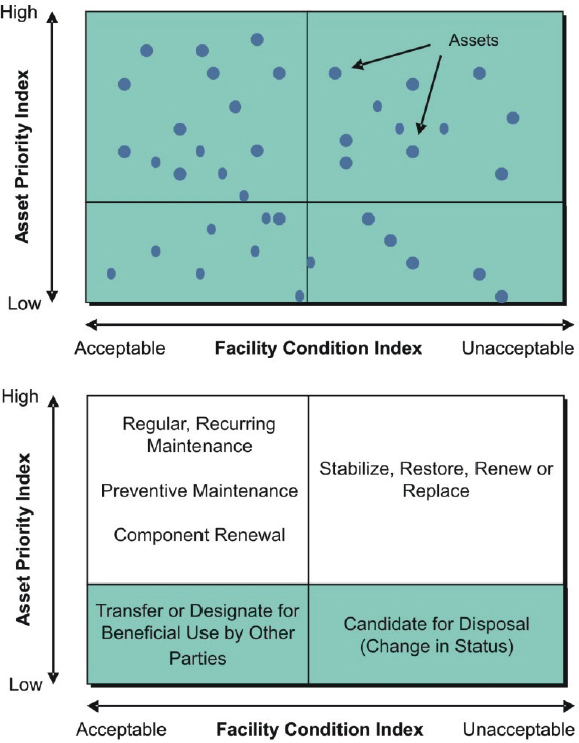
SOURCE: Office of Management and Budget, 2017, Capital Programming Guide: 2017 Supplement to OMB Circular No. A-11, Washington, DC, www.whitehouse.gov/wp-content/uploads/2021/01/capital_programming_guide.pdf.
Presenting the data in this way provides insight into the relative importance of an asset compared with other assets.
The committee supports ISO 55002 and OMB’s guidance but urges agencies to employ a range of facility asset management decision-making objectives, and recommends evolving federal policy to make use of an Operational Readiness Index (ORI) as part of a method of communications supporting federal facility renewal strategy implementation. The ORI would be based on a multicriteria decision-making analysis, considering inputs shown in Figure F-9.
Figure F-10 provides a hierarchical relationship across three key performance indicator (KPI) levels; agencies could tailor the ORI calculation. The
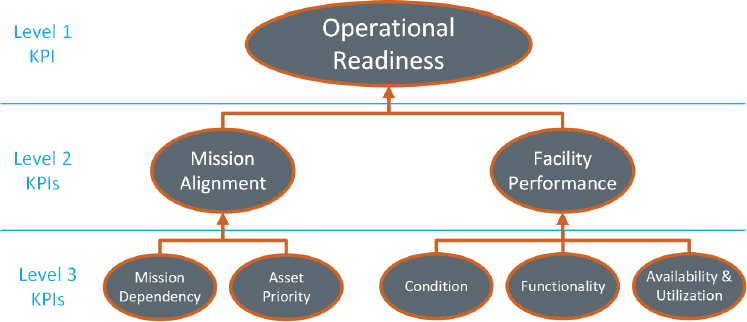
NOTE: KPI = key performance indicator.
darkened ovals indicate different data used in ORI calculations configured for specific decision-making purposes:
A summary of the use cases presented in Figure F-10 follows:
- The first use case employs all ORI subordinate KPI inputs. This is useful when performing a comprehensive analysis evaluating the relationship between an asset portfolio’s operational readiness and resource management plans and strategies across the enterprise.
- In the mission critical maintenance analysis use case, the ORI calculation uses mission dependency and the condition index. This is because these two KPIs are directly related to maintenance requirements supporting immediate operational needs. This use case is commonly applied to prioritize recurring major maintenance projects.
- The next use case supports a long-term space analysis, seeking to optimize space for a location or region over an extended period. In this use case, ORI is configured to be attentive to both mission dependency and asset priority criteria, joined with asset availability and utilization data.
- The last use case, stewardship objective analysis considers specific criteria reported using asset priority criteria and functionality data related to a stewardship objective. This ORI calculation is often used to develop strategies and prioritize actions related to environmental issues, energy goals, and regulatory requirements.
These use cases highlight ORI’s versatility addressing a wide range of resource decision making objectives supporting federal facility renewal strategy development. This construct is also supportive of earlier discussions making use of facility asset performance metrics.
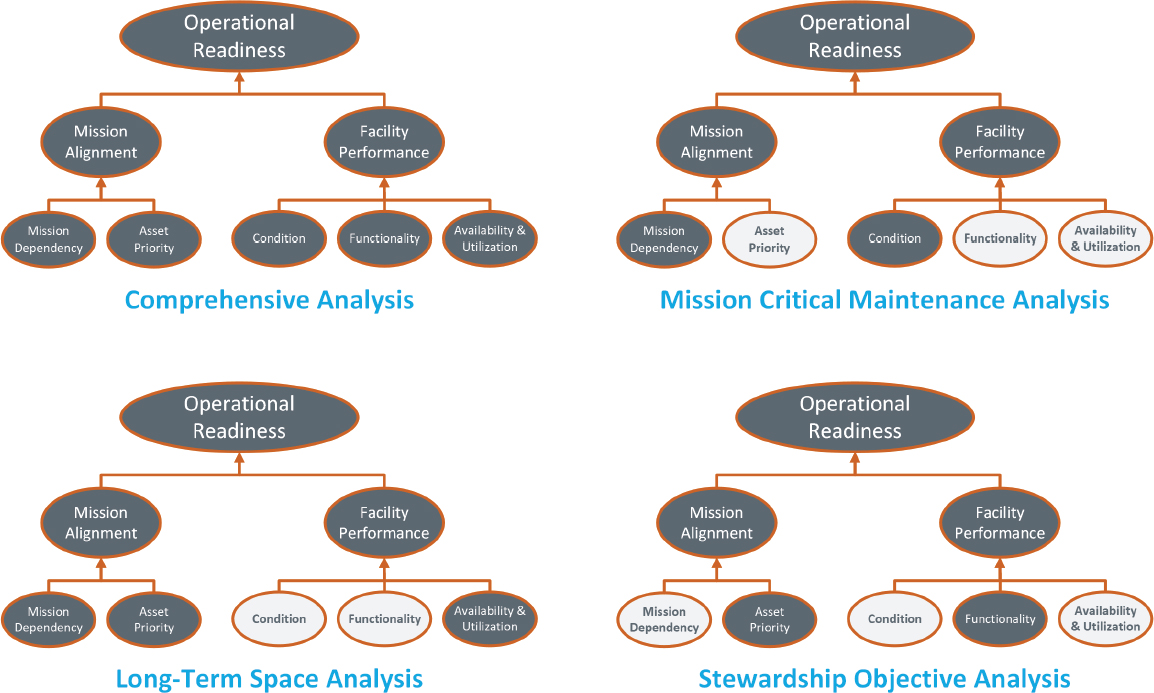
The Army National Guard’s Readiness Center Transformation Master Plan (RCTMP) successfully used operational readiness methods in 2014. Created in response to Congressional Directive 111-201, the Army National Guard used six specific criteria and performed an investment analysis for the 70 million–plus square feet of Readiness Centers scattered over 50 states, 3 territories, and the District of Columbia. Each Army National Guard entity generated a traditional master plan to create a priority list of military construction projects. The Army National Guard used these plans to develop a nationwide capital investment strategy using the national recommendation framework shown in Figure F-11.
ORI was the basis of the Army National Guard’s investment strategy, and the two criteria used in its calculation were a Readiness Center stewardship analysis that included space utilization, facility condition, and mission functionality. The National Guard got this information from the Army’s Installation Status Report system metrics. The mission dependency used the same method developed earlier. It evaluated the Army National Guard’s mission dependency based on each Readiness Center and not on each facility asset. The National Guard then joined the resulting stewardship and mission dependency to identified target ORI ranges that optimally balanced costs and risks to achieve their mission objectives as shown in Figure F-12.
This methodology provided the basis for competing more than 2,000 individual military construction projects from Readiness Centers located around the nation. Traditional master plans generated by each state, territory, and the District of Columbia hardwired strategies for projects in each. The National Guard then
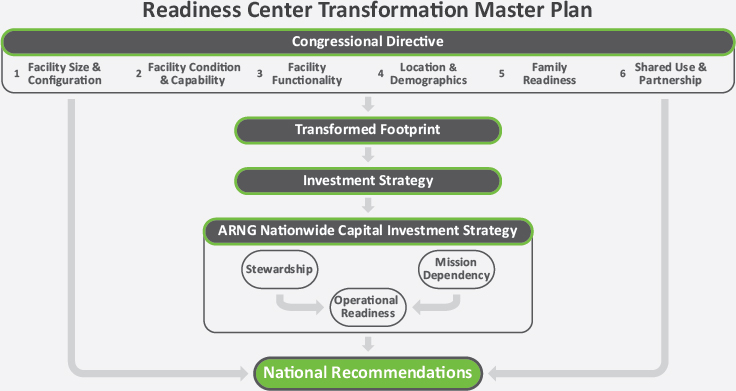
SOURCE: U.S. Army National Guard, 2014, Transformation Master Plan, Final Report to Congress, Washington, DC.
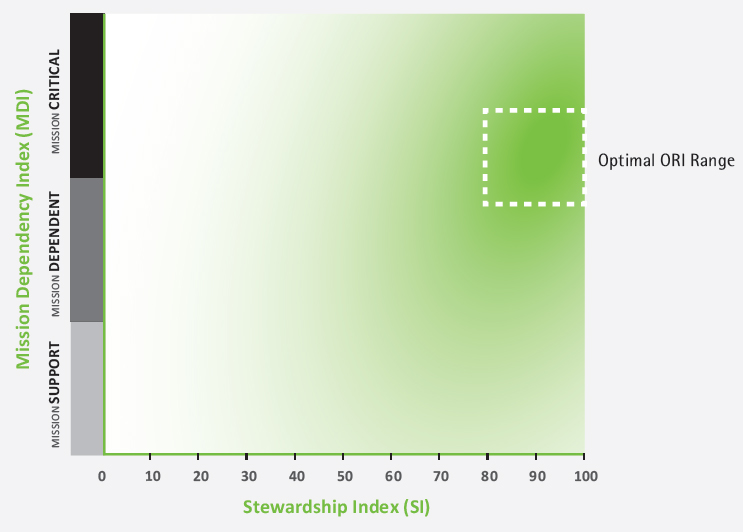
SOURCE: U.S. Army National Guard, 2014, Transformation Master Plan, Final Report to Congress.
used the ORI methodology outlined above to complete actions across the whole portfolio. The outcome was a 15-year, ~$28 billion investment strategy that evaluated the interdependencies between military construction and Facility Sustainment, Restoration, and Modernization funding, showing the cause and effect of different investment strategies on Army National Guard operational readiness. Figures F-13 and F-14 show a depiction of this analysis.
The Army National Guard RCTMP is the first-known use of the ORI and this methodology. Six years later, the Army National Guard is still using the RCTMP as the basis for facility investments across the nation. The RCTMP, with the help of the ORI, provided executive decision makers and stakeholders with a clear and impactful way to understand the relationship between facility investments and the Army National Guard’s Operational Readiness. The committee recognizes the RCTMP as a leading example of a detailed, defensible agency facility renewal strategy.
Making use of the Army National Guard RCTMP example, the Air Force developed an investment analysis model called the Installation Health Assessment, introduced in 2017. This model made use of Air Force facility mission dependency and condition index data. It used MDI scores for each facility for
the mission dependency input. For facility condition, it used simplified models that incorporated Sustainment Management System (SMS)/Builder data as a starting point.
The Air Force then developed parametric forecasting algorithms to model the effect of different investment levels on individual facilities rolled up to the whole portfolio. Like the Army National Guard RCTMP, this provided a simple way to demonstrate the cause and effects of different investment strategies on the Air Force’s installation operational readiness, as shown in Figure F-15.
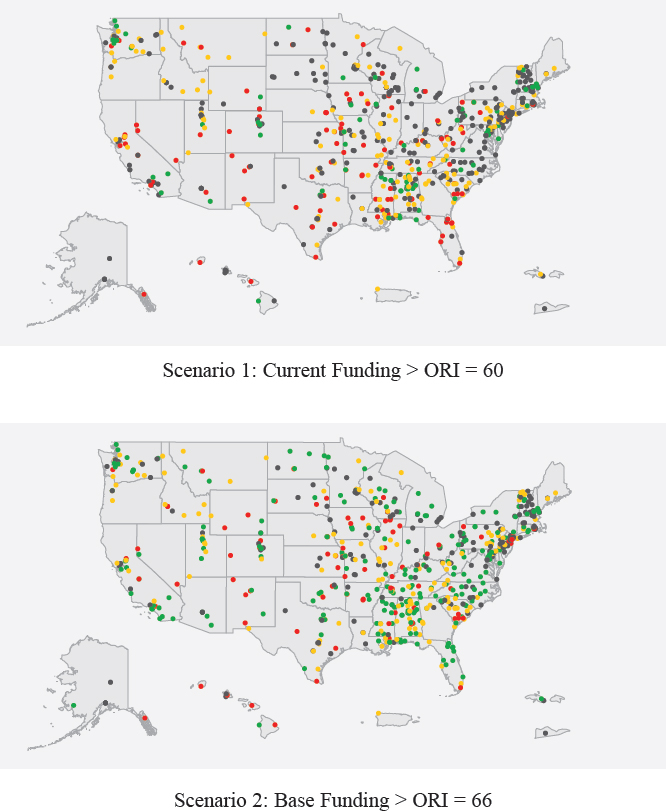
SOURCE: U.S. Army National Guard, 2014, Transformation Master Plan, Final Report to Congress.
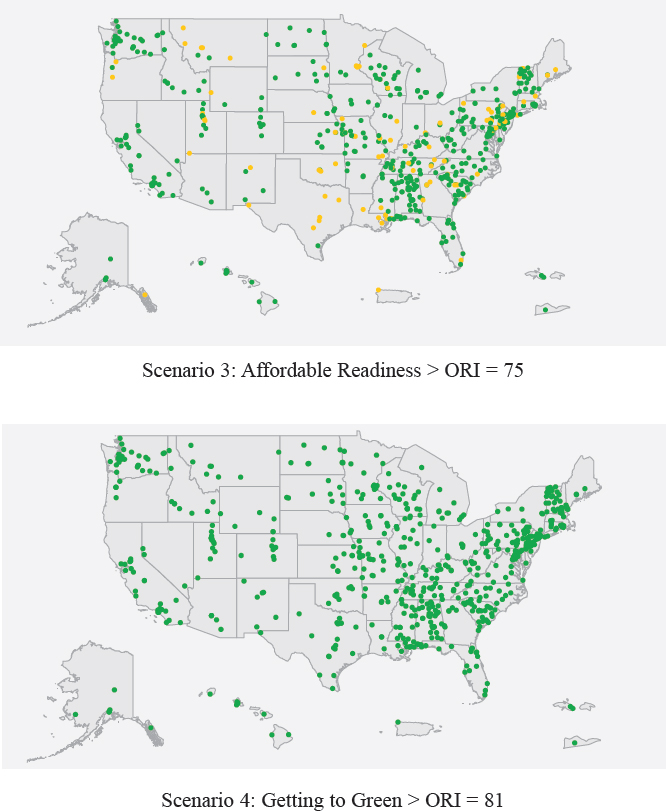
This Installation Health Assessment method was essential to the Air Force generating support for its Installation Investment Strategy (I2S), released January 29, 2019. The I2S is a centerpiece to a broad strategy defined in the Civil Engineering Annex of the Air Force’s Strategic Plan. The I2S establishes key objectives and performance criteria, supporting a measurable increase in Facility Sustainment, Restoration, and Modernization spending to be phased in over a 5-year investment horizon. Using the ORI to communicate the simple cause and effect between the Air Force’s facility renewal strategy and the operational readiness of Air Force’s mission capabilities drove an increase in facilities funding to
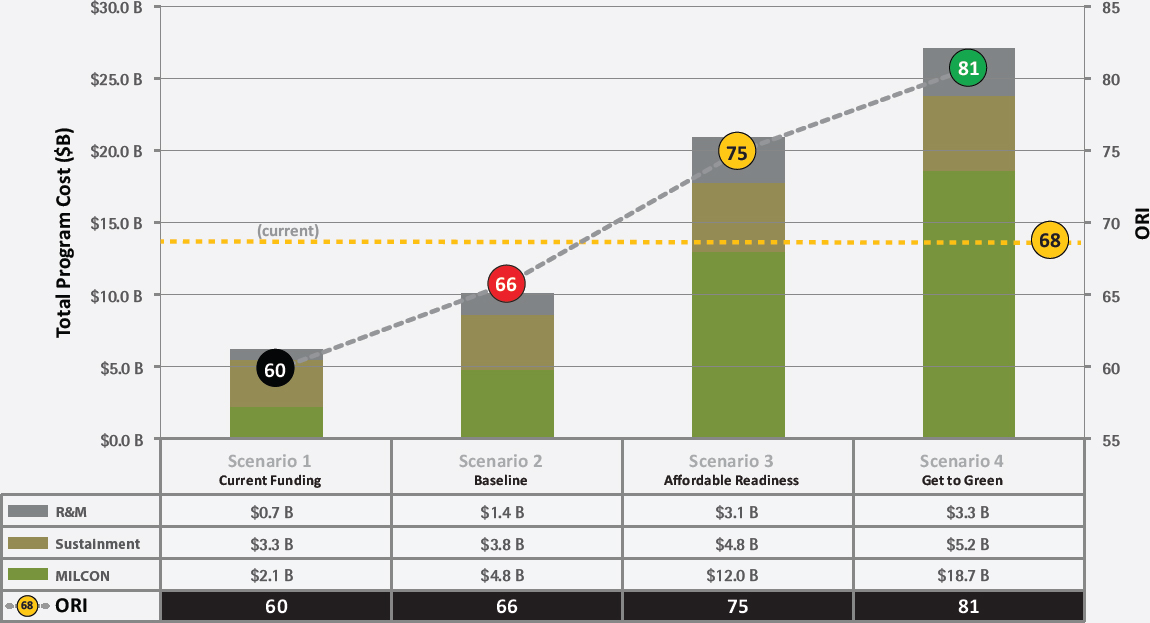
NOTE: MILCON = military construction; ORI = Operational Readiness Index; R&M = restoration and modernization.
SOURCE: U.S. Army National Guard, 2014, Transformation Master Plan, Final Report to Congress.
achieve the Air Force’s commitment to dedicate 2.3 percent of present retail value as the estimate for Facility Sustainment, Restoration, and Modernization funding.
The committee observes that the success of this Air Force strategy is based on three factors:
- It made use of high-quality, current, and accurate data reported on an individual facility-asset level. This includes inventory, condition, and mission dependency information.
- It made use of an intuitive analysis translating facility life-cycle needs into an operational readiness value proposition. This includes models based on SMS/Builder analysis joined with updated MDI data.
- It communicates findings of this investment analysis in a context important and understandable to operational commanders (i.e., operational readiness).
The Air Force Installation Health Assessment analysis in support of the I2S, like the ORI analysis in support of the Army National Guard’s RCTMP, is a leading example of beginner federal facility renewal strategies. They both provided a defensible, verifiable statement of facility requirements set within a life-cycle cost model. Furthermore, this approach relates the cause and effect of different investment strategies on facility performance across whole portfolios and investment horizons.
Through the operational readiness principle described in this report, decision makers can link facility life-cycle analysis to the achievement of agency mission objectives. This requires a current, accurate MDI to capture risks from an operational perspective, joined with current, accurate facility performance metrics. The outcome using an operational readiness–based analysis forms a basis for federal facility renewal strategy discussions of complex factors across whole facility portfolios.
PERFORMANCE–BUDGET INTEGRATION PRINCIPLE
Investment decision-making frameworks must evaluate planned-versus-
actual performance in a way that can simultaneously measure
a performance gap (e.g., a requirement) and the means to
remedy the gap related to budget development.
The preceding principles give evidence on how metrics can support risk-based facility asset management decision making. This principle expands on this and introduces how agencies can integrate these metrics with budget decision making when implementing federal facility renewal strategies. It also establishes capabilities responsive to the OMB M-20-10 requirement for the National Strategy on
the Efficient Use of Real Property to include “an assessment of how the federal government accounts for real property assets on the balance sheet” (OMB 2020a).
Figure F-15 depicts an enterprise risk management framework capable of linking asset performance and budget integration. This framework is applied through an iterative process supporting implementation of federal facility renewal strategies as follows:
- Facility asset management system–defined performance standards are used to set target performance levels. These standards need to establish performance levels that estimate the costs to deliver different levels of asset or asset portfolio performance.
- Facility asset management plans make use of many performance standards to establish strategies and plans for achieving performance objectives for assets and asset portfolios.
- Facility asset management plan performance objectives are linked to facility asset management objectives expressed in the agency’s real property capital plan.
- The real property capital plan integrates performance objectives administered through many facility asset management plans to inform agency PPBE decision making. This links agency facility renewal management to budget development activities in accordance with guidance in the OMB Capital Programming Guide.
- Agency PPBE processes obtain budgets and allocate funds to achieve objectives organized through the agency’s real property capital plan.
- Execution of the real property capital plan delivers solutions supporting the achievement of asset and asset portfolio objectives first established in the development of facility asset management plans, using facility asset management performance standards.
- Gaps between target and actual performance identified in assessments measure risk to readiness. The use of facility asset management standards simplifies measurement of performance gaps and development of the means to remedy gaps.
In this framework, target performance is linked to an observable facility performance standard. A simple example can be based on the U.S. Army Corps of Engineers’ SMS, Paver. This system is used to report the physical condition of a pavement, such as an aircraft runway—for example, the condition of all runways should be maintained at a condition index greater than 86. Setting this target requires the organization to develop construction and maintenance standards for maintaining runways at this condition index value.
This is an iterative, complex activity, but when systematically implemented, a life-cycle cost profile can be generated applying this strategy for the assets being serviced. This strategy can then be translated into a requirements-based budget forecast covering multiple years. As represented in Figure F-16, if the
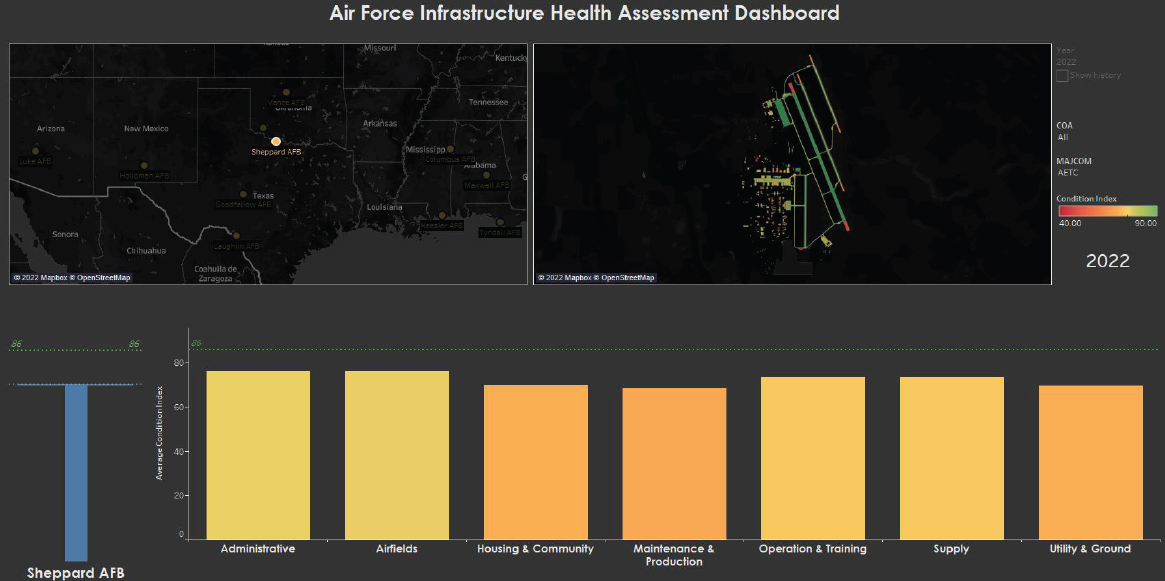
SOURCE: Courtesy of Air Force Installation and Mission Support Center Analytics.
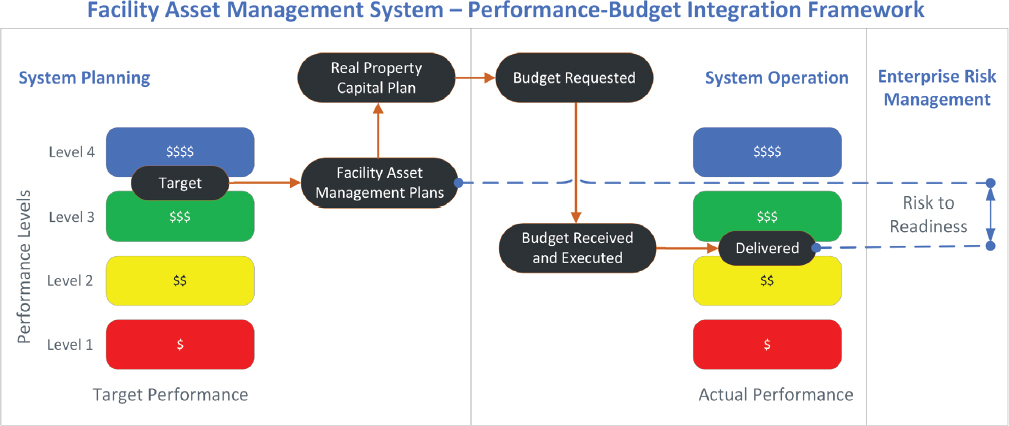
SOURCE: U.S. Army Corps of Engineers, 2012, Project Maintenance Management Development Guidelines, Washington, DC.
budget process does not deliver funding at required levels, the maintenance strategy will not be accomplished, and actual performance would be lower than expected. The outcome of this logical analysis is the ability to explicitly link material performance criterion to physical assets and then monetize the means to achieve or sustain set performance targets. In turn, this simple model can be applied across a comprehensive set of performance standards that, when applied to facility portfolios, can provide a fact-based analysis for budget, resource, and investment decision making.
This framework is predicated on an agency’s ability to develop relevant and responsive performance standards. A best practice is to start with measurement areas detailed in the facility performance principle. Agencies must then configure their facility asset management systems to determine optimal performance standard targets. Methods to do so include Monte Carlo, goal seeking, and performance-based analysis. Value generated employing this principle is improved when joined with the operational readiness principle because it raises the value proposition from asset life-cycle management to organizational performance.
On the scale of a federal facilities renewal strategy, this involves modulation of hundreds of standards and planning factors. This evaluation is represented conceptually on a strategic level in Figure F-17.
Figure F-17 introduces how agencies can view macro configuration of their facility asset management system. Configuring an asset management system
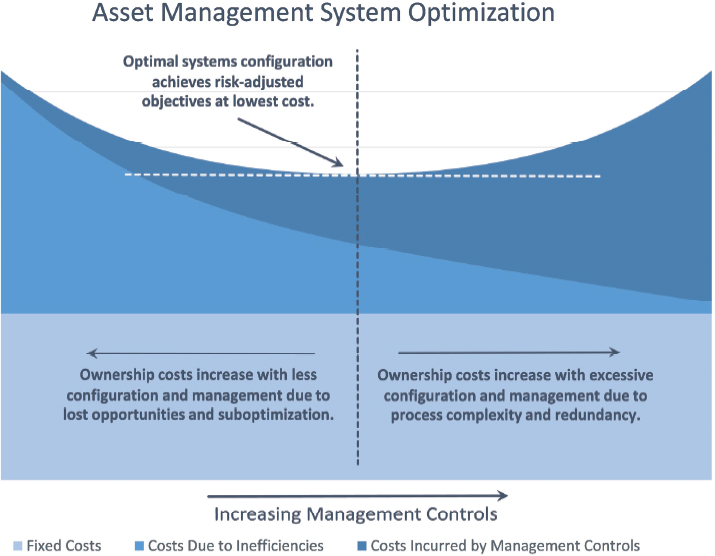
involves balancing risks and costs to establish an optimal strategy for achieving targeted performance objectives. This is an iterative process, evaluating planned-versus-actual performance and tracing the setting of performance-standard levels through development of the agency’s real property capital plan using the agency PPBE process to assess the outcomes of facility program execution. As detailed in Chapter 3, these are essential capabilities of facility asset management systems supportive of OMB policy and ISO 55000 standards.
BALANCE SHEET ANALYSIS PRINCIPLE
Federal facility renewal strategies gain credibility based on their ability
to reconcile a comprehensive and exhaustive set of facility requirements
and capabilities against resources using a balance sheet analysis.
This second-to-last principle completes the logic responding to the OMB M-20-10 requirement for strategies to include “an assessment of how the federal government accounts for real property assets on the balance sheet” (OMB 2020a). The committee views this not only as a good practice, but as a requirement for effective federal facility renewal strategies. To implement this principle, agencies must demonstrate that their facility renewal strategy is comprehensive and exhaustive.
Comprehensive involves assurance that the strategy covers the entire facility portfolio and the stakeholders’ needs it supports. Exhaustive means assuring that the strategy addresses all important details. Obtaining these assurances must be inherent to facility asset management system function and the decision-making products it generates (e.g., comparing a requirements-based budget for a facility portfolio with the budget allocated to fulfill these requirements).
To demonstrate these assurances, agencies will need to produce facility portfolio balance sheets reconciling facility requirements and capabilities as part of their facility renewal strategies. Balance sheets list requirements to include desired performance levels to be delivered by federal facilities renewal strategies and the resourcing strategy supporting it. This balance sheet analysis must cover all facility programs coordinated by the real property capital plan and all associated performance objectives. Application of the operational readiness principle is designed to simplify this process by providing a relevant basis to formulate complex risk-based resource-and-investment decisions understood by many key stakeholder groups.
Furthermore, given OMB Circular A-11 and A-123 requirements, and as detailed in ISO 55000 standards, this analysis must be configured as a continual improvement process, evaluating performance as a trend analysis and using this analysis to forecast future performance. This provides a cause-and-effect analysis to evaluate how different requirements-and-maintenance funding strategies would affect performance outcomes. For example, if a certain sum of dollars is
required to maintain aircraft runways at a condition index of 86, and if this sum is not allocated for this purpose, it will then be possible to determine when, how, and why this condition performance target will not be achieved.
Trends must be based on evaluation of past performance and be used to develop forecasting models. Forecasting models must also account for influential factors and planning criteria. Confidence in forecasting models is increased through planned-versus-actual comparisons that could be augmented through data science. Demonstration of assurance can be achieved through balance sheet analysis reporting linked to performance metrics and resource-and-investment strategies that can be understood by key stakeholders.
FACILITY ASSET MANAGEMENT SYSTEM MATURITY PRINCIPLE
To ensure and assure that renewal strategies will lead to desired benefits, they
must be supported by a facility asset management system that is periodically
and rigorously assessed and reviewed using an objective maturity scale.
The last and one of the most frequently overlooked principles is the evaluation of facility asset management system maturity. OMB policy does not require it, except through assurance statements required in OMB Circular A-136—Financial Reporting Requirements, which are rarely applied to federal facility management. OMB Circular A-11 comes close to this requirement by requiring maturity models for data quality, agency strategic reviews, and customer experience. These are good uses of a maturity-based analysis, but none work for evaluating the maturity of a management system. More specifically, OMB Circulars A-11 and A-123 provide guidance on how to manage resources supporting capital assets, but do not provide guidance on how to evaluate an agency’s competency to do so. Whereas ISO 55001 is the only authoritative source known to be able to do this. In fact, as stated in ISO 55001, doing so is an asset management system requirement: “the organization shall evaluate and report on: asset performance, asset management performance (including financial and non-financial performance), [and] the effectiveness of the asset management system” (ISO 2014b, § 9.1.d).
This is a confidence-building objective for asset management system products and foundational services and promotes continual improvement. Agencies that can demonstrate a fully functional facility asset management system are much more likely than those who cannot to generate effective federal facility renewal strategies. Doing so may be the fastest and most effective way to graduate federal real property management from the GAO High-Risk list.
It is for these reasons the committee recognizes the importance of facility asset management system maturity assessments. Leading knowledge-based asset management organizations around the world promote the use of asset management
maturity assessments. These organizations include the Asset Leadership Network,3 The Institute of Asset Management,4 the Asset Management Council,5 the Institute of Public Works Engineering Australasia,6 and the Global Forum for Maintenance and Asset Management.7 They agree on using ISO 55001 as the basis for evaluating an organization’s asset management system maturity. The general approach used by each involves a series of questions to score maturity across management domains, correlating to ISO 55001 subclauses, as detailed in Figure F-18. A typical summation of an assessment is shown in the spider-web diagram in Figure F-19.
In Figure F-19, the asset management maturity level is 2.20 for the organization being assessed. This is computed on a scale ranging from 0 to 4, with higher numbers indicating higher levels of asset management system maturity. This
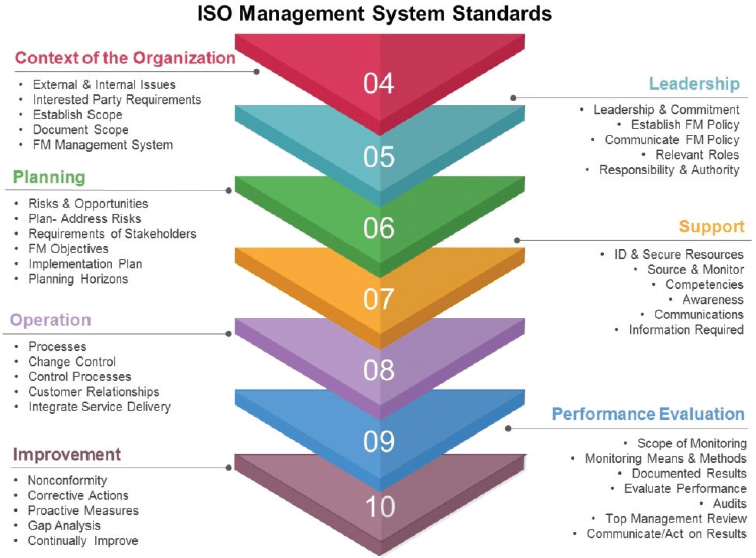
SOURCE: Courtesy of J. Whittaker, global product owner, Engineering Services, JLL Work Dynamics.
___________________
3 For more information, see Asset Leadership Network, https://www.assetleadership.net.
4 For more information, see The Institute of Asset Management, https://theiam.org.
5 For more information, see Asset Management Council, http://www.amcouncil.com.au.
6 For more information, see Institute of Public Works Engineering Australasia, https://www.ipwea.org/home.
7 For more information, see Global Forum on Maintenance & Asset Management, https://gfmam.org.
maturity score is computed as an average score across each ISO 55001 management domain. Using an objective, independent standard, such as ISO 55001, for asset management system assessments is essential because it supports the ability to evaluate a progression in maturity from one assessment cycle to another, as shown in Figure F-20.
Figure F-20 shows an organization’s progression in asset management maturity over three evaluation cycles, measured from a baseline assessment. Using a consistent, objective standard to perform this assessment is essential for supporting third-party validation and organizational learning. The committee views this type of assessment as critical to agencies seeking to improve their facility asset management system capabilities, which is a means to improve their facility renewal strategies.
